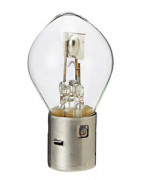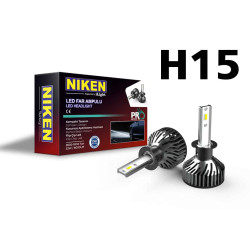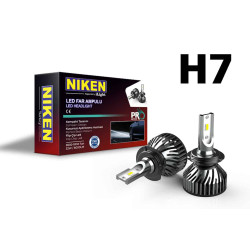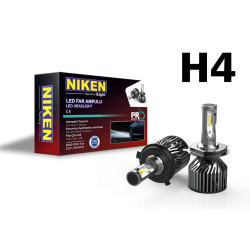Light On Car Parts
Homepage
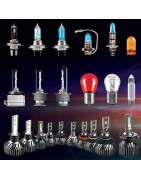
Subcategories
-
Car Bulbs
Car lighting bulbs for low and high beam headlights, brake, signaling, fog lights, position, sidelights, reverse, parking, tail lights, interior cabin and trunk lights. Original lighting spare parts at competitive prices.
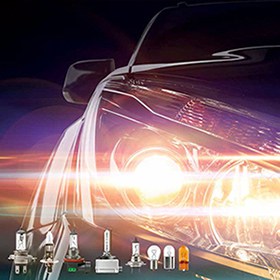
Car headlight bulb types
As automotive lighting technologies are developing and becaming mainstream it’s no surprise that the car lights are also evolving.
Advances in technology have given us three common bulb types: halogen, xenon / high intensity discharge (HID), and light emitting diodes (LED)
Halogen headlights bulbs
Halogen car lights are the most popular kind on our roads today. They use a combination of gases - usually nitrogen and argon – and a tungsten (wolfram) filament in a glass tube. Standard halogen, Night Vision, and Sky Blue categories of halogen bulbs which diferentiate them according to the production technology. ECE types for halogen car bulbs: H1, H3, H4, H7, H8, H9, H10, H11, H12, H13, H15, H27, HIR1, HIR2, HB3, and HB4 standard or miniature car lighting bulbs.
Xenon / HID headlights bulbs
Xenon high intensity discharge (HID) headlights bulbs are heating gases and are using rare metals with special properties to generate a bright white light or a blue glow light.
Xenon bulbs are up to three times brighter than halogen bulbs with the same wattage. HID lamps need more power to start up than halogen lamps but they will operate at a much lower power usage afterwards. Also Xenon car bulbs will have a greater lifespan than halogen car bulbs. ECE types for Xenon car bulbs: D1S, D2S, D3S, D4S, D5S, D8S, D2R, and D4R 4300K Standard xenon, 6000K Sky Blue xenon, and 4300K Long Life xenon bulbs.
LED headlights bulbs
On the LED car bulbs the long-lasting light source is small and hese the directional focused lights. Also the LED lights are brighter than ones of halogen bulbs of the same power wattage as well. LEDs car bulbs produce a small amount of heat at the emitter level when electricity passes through and require a performant cooling system to work at designed parameters. ECE types for LED headlights car bulbs: H1, H3, H4, H7, H10, H11, H15, H27, 9005, 9006, 9012, D1S, D2S, D3S and D4S as halogen and xenon lights replacements.
 There are several lights on our cars: indicators that double up as hazard lights, tail lights that sit next to brake lights, and headlights that we can set to different modes.
There are several lights on our cars: indicators that double up as hazard lights, tail lights that sit next to brake lights, and headlights that we can set to different modes.Dipped headlights
Dipped headlights, sometimes known as low beams, are the most commonly used headlights. They are brighter than sidelights, but not as bright as full beam headlights. They are angled downwards, towards the road. They should be turned on at night-time, during bad weather and at day-time if it is mandatory by law and your car it is not factory equiped with LED running day lights.
Full beam headlights
Full beam headlights are the brightest type of headlight on normal vehicles. They are angled higher than dipped headlights, allowing you to see more of the road, and are sometimes known as high beams. You should only use full beam headlights on unlit stretches of road at night or non public roads.
Fog lights
Fog lights are designed to cut through fog and mist, unlike full beam lights that are reflected by fog. They are positioned on front and back of the vehicle. In vehicle's front it is used a clear type light, with a yellow tint, and on the back lamp the light is of high intensity of red color.
Signal and hazard warning lights
The signal lights can be seen on all corners of the car as well as on the sides of the car. Their way of working is on pulsating manner to have a better visibility when warning other road participants about the change of direction of travel or changing the lanes. The hazard lights are the same as the lights used for signaling, all operating at the same time to announce an unexpected road event.
Indicators or position lights, sidelights
The position lights are at the front, rear and sides of the car. They warn other road participants about the size of the car and its external limits.
Reverse lights
Reverse lights are of white color and found on the back of your car. They’re turned automatically on at the same time as you put you car in the reverse mode. This type of light will help you have a better view at night on the back of your car when you are parking or drive backwards.
Brake lights
The brake lights are red in color with high luminous intensity and are usually located in the taillights behind the car. These light signals given by the car stop bulbs are to show the other drivers that you have applied the brakes of the car and that you are slowing down, sometimes until the car is stopped.
Interior lights
Interior lights are defined as lights of car's cabin and trunk. They’re door lights, dome lights, map reading lights, accent lights, comfort lights, glove compartiment lights, and trunk interior lights.
-
Truck Bulbs
Truck and trailer 24V lighting bulbs for low and high beam headlights, brake, signaling, fog lights, position, sidelights, reverse, parking, tail lights, and interior cabin lights. Original truck motor unit and trailer lighting spare parts at competitive prices.

Truck and trailer 24V headlight bulb types
As automotive lighting technologies are developing and becaming mainstream it’s no surprise that the truck lights are also evolving.
Advances in technology have given us three common bulb types: halogen, xenon / high intensity discharge (HID), and light emitting diodes (LED).
Halogen truck headlights bulbs
Halogen 24V truck and trailer lights are the most popular kind on our roads today. They use a combination of gases - usually nitrogen and argon – and a tungsten (wolfram) filament in a glass tube. Standard halogen, Miniature, and Truck Vision Heavy Duty categories of halogen bulbs which diferentiate them according to the production technology. ECE types for halogen car bulbs: H1, H3, H4, H7, H11, H15, and H21W of standard, miniature, and performance truck lighting bulbs.
Upgraded halogen 24V truck bulbs Truck Vision Heavy Duty
Performance truck halogen headlights are offering at night driving a more road visibility, more luminous intensity, maximum light output, more whiter light, as well as high-end lighting technologies. Halogen Truck Vision Extra Heavy Duty truck bulbs from Wolfram set new standards for truck headlighting with their increased visibility of up to 150% extra light, extra lifetime of up to 2.5 times longer life than truck halogen standard bulbs, and being extra heavy duty bulbs with very high vibration resistance.

Xenon light bulbs 4300K standard, 6000K white light and Ultraviolet 4300K and 6000K models for truck headlight
All Wolfram xenon bulbs in the car category can be used to replace xenon bulbs in trucks.
Thus, here we will find the standard Xenon 4300K Brown series, the Xenon 6000K Blue white light and the Xenon Ultraviolet series with standard 4300K models and 6000K white light.
There are several 24V lights on our trucks: indicators that double up as hazard lights, tail lights that sit next to brake lights, and headlights that we can set to different modes.
Dipped headlights
Dipped headlights, sometimes known as low beams, are the most commonly used headlights. They are brighter than sidelights, but not as bright as full beam headlights. They are angled downwards, towards the road. They should be turned on at night-time, during bad weather and at day-time if it is mandatory by law and your truck it is not factory equiped with LED running day lights.
Full beam headlights
Full beam 24V headlights are the brightest type of headlight on normal vehicles. They are angled higher than dipped headlights, allowing you to see more of the road, and are sometimes known as high beams. You should only use full beam headlights on unlit stretches of road at night or non public roads.
Fog lights
Fog lights are designed to cut through fog and mist, unlike full beam lights that are reflected by fog. They are positioned on front and back of the vehicle. In vehicle's front it is used a clear type light, with a yellow tint, and on the back lamp the light is of high intensity of red color.

Signal and hazard warning lights
The 24V signal lights can be seen on all corners of the truck motor unit and trailer as well as on the sides of them. Their way of working is on pulsating manner to have a better visibility when warning other road participants about the change of direction of travel or changing the lanes. The hazard lights are the same as the lights used for signaling, all operating at the same time to announce an unexpected road event.
Indicators or position lights, sidelights
The position lights are at the front, rear and sides of the truck motor unit and trailer. They warn other road participants about the size of the road assembly and its external limits.
Reverse lights
Reverse lights are of white color and found on the back of your truck and trailer. They’re turned automatically on at the same time as you put you car in the reverse mode. This type of light will help you have a better view at night on the back of your truck when you are parking or drive backwards.
Brake lights
The 24V brake lights are red in color with high luminous intensity and are usually located in the taillights behind the truck motor unit and the trailer. These light signals given by the truck assembly stop bulbs are to show the other drivers that you have applied the brakes of the truck and that you are slowing down, sometimes until the truck is stopped.
Interior lights
Interior lights are defined as lights of truck's cabin. They’re door lights, dome lights, map reading lights, accent lights, comfort lights, glove compartiment lights, and trunk interior lights.
-
Motorcycle Lights
When you're choosing a motorcycle light bulb, remember that the motorcycle lights are designed to make your bike safer as they are smaller than an average car and it may be harder for other road participants to see your presence nearby. Bright headlights, correct position lights, plus clearly visible tail lights and turn signals will go a long way to helping other drivers see you.

Headlamps, rear lights, position lights, and turn signal lights are mandatory appliances on most motorcycles that want to be driven on public roads. If you are an off road passionate, the lights on your bike can be dismissed as you don't need them when enjoying the out of the road ride and the safety purpose of the motorcycle lights is obsolete in this scenario.
Motorcycle headlight bulbs
Headlights are one of the most important safety features on a motorcycle. As well as illuminating the road ahead, you're making yourself visible to other drivers on the road, especially at night. It's more than likely that your motorbike was originally fitted with halogen bulbs. Halogens motorcycle lights can be bright and serve very well as motorcycle headlights. Your motorbike’s headlights must emit either white with a yellow tint or a pure white color light.
Motorcycle tail light bulbs
Tail lights are the second most important light on your motorcycle. Like headlights, tail lights are a crucial safety feature: they help increase the visibility of your motorbike to other drivers. Tail light units for motorcycles also typically include your brake light, which is another important safety feature. One factor to keep in mind with tail lights is colour, as in almost every country, tail lights are legally required to be red colored. This lets other drivers on the road know that they're looking at the back of a vehicle, and not the front of it where the light colors are white.
Motorcycle front and rear position light bulbs
The front light must emit a white light, unless it is within a yellow headlamp, and the rear must always be a red light. The front position light, or sidelight, is considered separate from the motorcycle’s headlight unit. The rear position light may, or may not, be integrated on the tail light unit.
Motorcycle turn signal lights or indicators bulbs
Turn signals are the final piece of lighting required on motorcycles. You can choose from a variety of styles, including both front and rear. Some riders prefer longer stalk turn signals, whilst others prefer them flat on the bike.
In addition to headlights, tail lights, position lights, and turn signals, some motorcycle owners choose to add accessory lights onto their bike. These lights are not necessary and are used for style purposes only. Please note that accessory lights are not always road legal, as they can be too bright or distracting for others on the road.
If the motorcycle lights fail to work, you must replace the broken bulb within a set timeframe. The longer you go without using your motorcycle lights, the more risks you present to other road participants. That’s why the law requires the motorcycle lights to work properly at all times when you are driving it on public roads.
-
Car service package
Car periodic maintenance service package for Audi, BMW, Dacia, Ford, Opel, Renault, Skoda, and Volkswagen.
The car maintenance service overhaul packages include engine air filter, passenger cockpit air filter, petrol or diesel filter, engine oil filter, and engine oil.
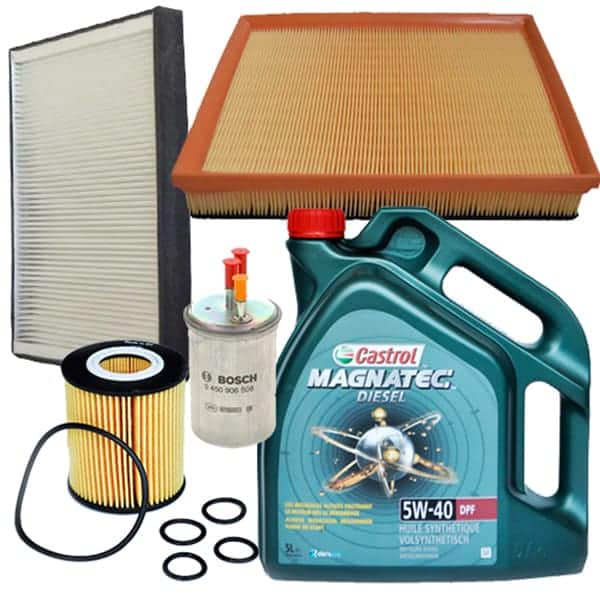
Periodic maintenance service for a car is essential for several reasons:
1. Prolonging the lifespan of the car: Regular maintenance helps identify and address minor issues before they turn into major problems. By addressing these issues promptly, you can prevent them from causing more significant damage to the vehicle. Regular oil changes, filter replacements, and fluid top-ups, for example, keep the engine running smoothly and can extend its lifespan.
2. Ensuring safety: Regular maintenance plays a vital role in ensuring the safety of both the driver and passengers. Components such as brakes, tires, suspension, and steering need to be checked and serviced regularly to ensure they are functioning correctly. Faulty brakes or worn-out tires can compromise the vehicle's ability to stop quickly and handle properly, which can lead to accidents.
3. Optimal performance and fuel efficiency: Regular maintenance helps maintain the car's optimal performance. Components like the engine, transmission, and exhaust system need to be inspected and serviced regularly to ensure they are functioning efficiently. Clean filters, properly lubricated parts, and well-maintained systems contribute to better fuel efficiency, saving you money on fuel costs.
4. Warranty requirements: Many car manufacturers require regular maintenance as part of their warranty conditions. Failing to adhere to the recommended maintenance schedule may void your warranty. It's important to keep accurate records of maintenance performed, including dates, mileage, and receipts, to support any warranty claims.
5. Resale value: A well-maintained car typically has a higher resale value than one that has been neglected. Regular maintenance records demonstrate that the vehicle has been cared for, which can instill confidence in potential buyers. If you plan to sell or trade-in your car in the future, regular maintenance can help maximize its value.
6. Prevention of costly repairs: Regular maintenance helps identify potential issues early on, allowing you to address them before they become expensive repairs. Routine inspections and servicing can catch problems such as fluid leaks, worn-out belts, or failing components, which, if left unattended, could lead to more significant and costly repairs down the line.
Overall, periodic maintenance services are crucial for preserving the performance, safety, and longevity of your car while ensuring optimal fuel efficiency and potentially saving you money in the long run.
Car periodic maintenance service packages can vary depending on the manufacturer, model, and specific requirements of your vehicle. It's important to note that you should always consult your vehicle's owner's manual or contact your authorized dealership for precise information regarding your car's recommended maintenance schedule. Here are some common services included in periodic maintenance service packages:

1. Oil Change: Regularly changing the engine oil and oil filter is crucial for optimal engine performance and longevity.
2. Fluid Checks and Top-ups: Inspection and replenishment of essential fluids, including coolant, brake fluid, power steering fluid, transmission fluid, and windshield washer fluid.
3. Tire Rotation: Swapping the position of the tires to ensure even tread wear and maximize tire life.
4. Wheel Alignment: Adjusting the angles of the wheels to ensure they are perpendicular to the ground and parallel to each other, promoting even tire wear and stable handling.
5. Brake Inspection: Checking the condition of brake pads, brake discs/rotors, and brake fluid levels to ensure safe braking performance.
6. Air Filter Replacement: Replacing the engine air filter to maintain proper air flow and protect the engine from contaminants.
7. Cabin Air Filter Replacement: Replacing the cabin air filter to ensure clean air circulation within the vehicle's cabin.
8. Spark Plug Replacement: Periodically replacing spark plugs to ensure efficient combustion and optimal engine performance.
9. Battery Inspection: Checking the battery's condition, cleaning terminals, and ensuring proper charging system operation.
10. Visual Inspection: Comprehensive inspection of various components, including belts, hoses, suspension, exhaust system, lights, and wipers.
11. Diagnostic Scans: Conducting computerized scans to identify and address any potential issues or error codes stored in the vehicle's system.

It's important to remember that these services can vary depending on your car's make, model, age, and mileage. It's always a good idea to consult your vehicle's manufacturer recommendations or your authorized dealership to determine the specific maintenance schedule and services required for your car.
We try to help you in performing periodic maintenance of car service by offering car service revision packages on 3 levels of equipment and price: ECONOMIC, PLUS, and PREMIUM car periodic service package.



